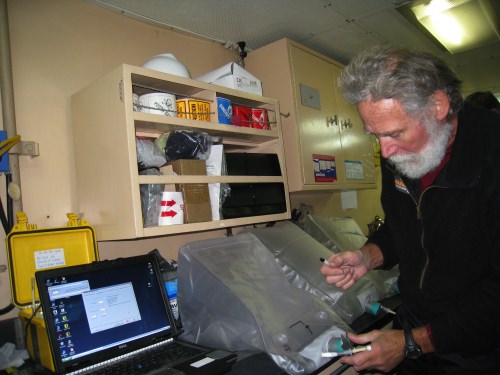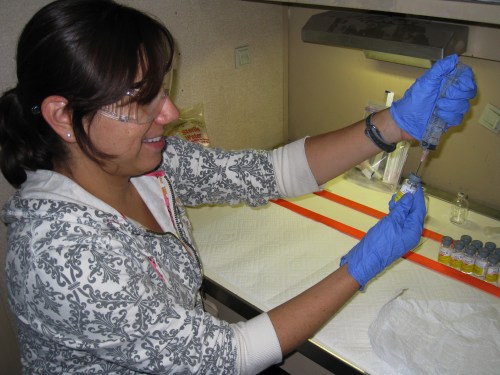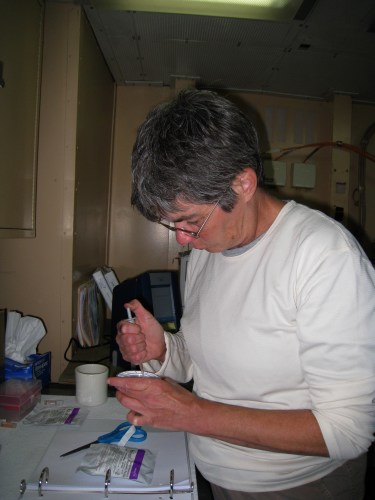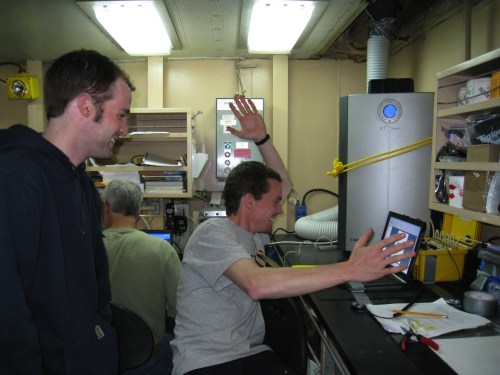Location: Lat: 77 25.1016 N Long: 166 55.59 W
Currently, I am awaiting for the team of researchers to return to the boat. We travelled another 65 miles north last night to get close to the next bear. We just got word back that they were able to successfully find the bear and her cub and they were able to find a safe place to work. They will be gone at least 3 hours while working in the field. When they return, then it will be time to analyze the blood and breath samples and prepare for another day of data collection for tomorrow.
I have received lots of questions about the project overview, so I thought I would try to explain it again now that I have a better understanding of everything that has already taken place.
In the spring time, members of the team travelled to Alaska to find polar bears to collect data on. The worked out of a small coastal community called Deadhorse on the Northern Alaska coast. They went out in helicopters and found bears either by following their tracks in the snow or by using radio signal from collars they were already wearing. Some bear might have been wearing collars already if they had been part of a previous study through University of Wyoming or US Fish and Wildlife.
The team took samples from the bears - fat, muscle, blood, hair, breath, etc. They also did a surgery to insert a probe to measure core body temperature. Finally, they placed collars on the bears with activity monitors (see journal entry 9 28 09). Last spring, they were able to place collars on 20 bears, but one bear tossed off her collar right away.
Over the summer, the bears lived and hunted as normal. The team knew that some of the bears would stay on land near Deadhorse and that others would follow the sea ice as it melted and be out on ice pans in the Arctic Ocean.
Then this fall, there are two teams who are set to go out and collect data at the the end of the summer. They are also going to do a small surgery to remove the temperature probe from the bears and remove collars. They will replace collars on the bears in hopes of coming back out next spring for another round of data collection. One team, composed of two graduate students, will be stationed in Deadhorse to look for the bears that stayed on land. The other team is here on the Polar Sea to track the bears who travelled out onto the sea ice.
It was a successful day today - the team was able to locate and successfully collect data on three bears total today. They were finally able to find ice that was thick and sturdy enough to work on the bears. The ice was about 2-3 feet thick, but places in between where the ice was only an inch or two thick. They had to be pretty careful as they traversed around the ice to not step on one of the thin areas.
When the team returned, they were filled with excitement about finally having a success and having data to analyze. We worked late into the night preparing samples, running tests, and preparing for the next day. One of the samples that was cool to work with was the polar bear breath. They collect large bags of polar bear breath to analyze CO2, levels as well as save some to analyze for stable isotopes when they return to Laramie. Of course, I couldn't resist smelling the breath - I wasn't sure what to expect, but I wasn't expecting it to be pleasant. I was surprised to find out that the breath didn't have much smell at all. It mostly just smelled like the plastic bag that it was stored in.

Another piece of preparation that has to happen after each successful bear capture day is to mix more of the tranquilizer drug. This has become my job. It's pretty straight forward. I have to mix a specific amount of sterile water with the drug and then place it all in one larger storage container.

The part of the data analysis that was the most time consuming was the blood analysis. We screened the blood for cholesterol and other lipids.

The most exciting part of the night was when we were able to look at the data from the temperature probe that had been removed. This was the first time ever of getting core temperature data on a polar bear in the wild for several months continuously. The team was so excited to finally get to look at some of the data that they had been the result of several years of work and planning and money. It reminded me of kids at Christmas time who were so excited to see what gifts they would get. I can't imagine how good it must feel to know that after all the work that there is good data just waiting to be analyzed.



Comments